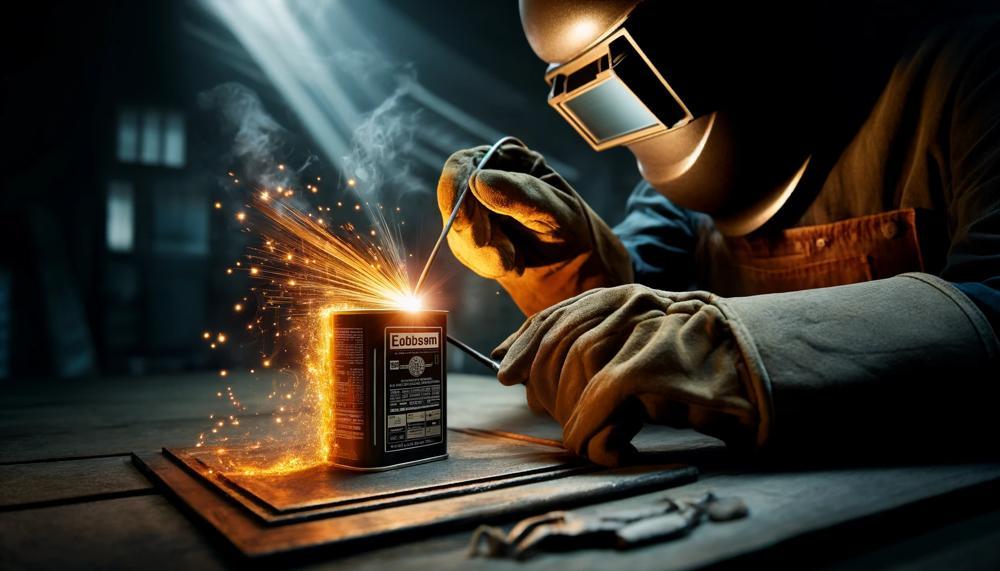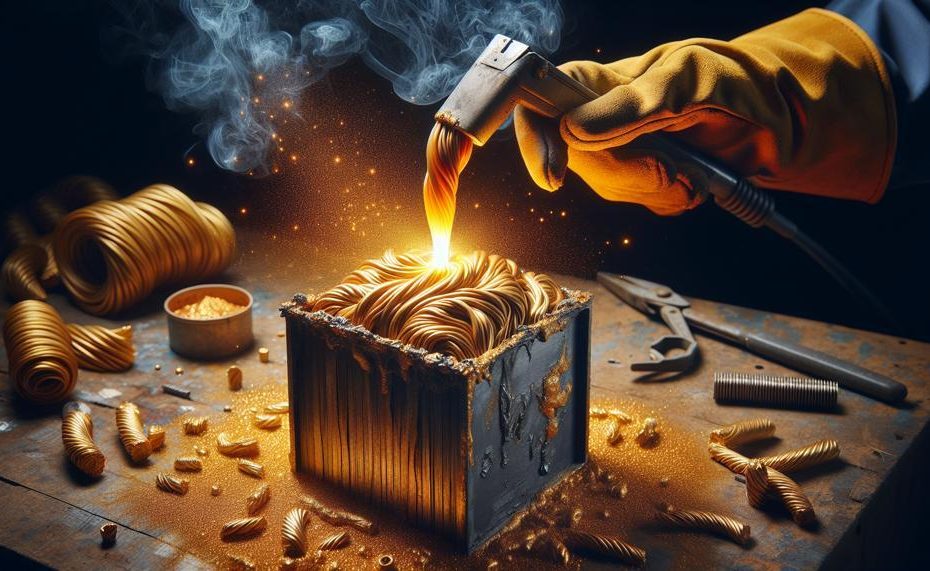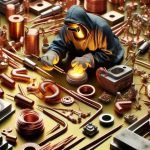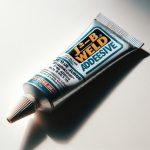In the heart of every spark, every bead, and every seamless join in the world of metalwork lies an unsung hero: welding flux. This critical player in the welding game might not grab headlines, but it’s the backbone of creating strong, durable, and clean welds that stand the test of time. Whether you’re a seasoned professional or a curious newcomer, understanding welding flux is your ticket to elevating your welding projects from good to exceptional.
So, what is welding flux?
You can protect melted metal from airborne pollutants with welding flux, which is a mix of chemicals, minerals, and alloying materials. Since the 1950s, you have been able to solder with flux, and it is now the recommended method over stick welding.
Flux protects the metal used in the weld process from
Other pollutants include rust, dust, oil, and dirt; oxidation; nitrogen; oxygen; and other contaminants.
Flux also helps manage an arc’s stability and mechanical properties. It may also:
- Remove the rust from the joint surface.
- Lessen the solder’s surface tension and melting point.
- Make sure the solder flows at a good speed to fill the weld.
Almost always, there is flux on top of the wire; it’s about 1mm to 3mm thick. Some electrodes contain flux in a hollow space inside them.
Mineral fluxes usually include borax, hydrochloric acid, zinc chloride, and ammonium chloride.
There are three kinds of flux welding: FCAW, SAW, and SMAW.
Let’s explore more.
Contents
What is Welding Flux Made of?
Welding flux, the unsung hero of the welding world, is a concoction designed to shield the weld area from oxidation and contaminants, ensuring that each weld is stronger and more reliable.

Crafted from a variety of granulated materials, its composition is a fine blend of minerals, metals, and chemicals, each selected for its unique properties to combat the challenges of welding environments.
Below, you’ll find a table detailing the main ingredients commonly found in welding flux, offering a peek into the complexity and precision involved in its creation.
| Ingredient | Function | Common Use |
| Silica (SiO2) | Forms a slag, assists in impurity removal | General welding applications |
| Limestone (CaCO3) | Stabilizes arc, fluxing agent | Steel and stainless steel welding |
| Aluminium oxide (Al2O3) | Controls viscosity of slag | High-temperature welding |
| Magnesium oxide (MgO) | Improves slag fluidity | For thick and heavy metals |
| Calcium fluoride (CaF2) | Enhances fluidity and detachability of slag | Stainless steel and high-alloy materials |
| Cellulose | Generates protective gases | Pipeline and structural steel welding |
| Rutile (TiO2) | Stabilizes arc, increases weld pool fluidity | General purpose welding |
Selecting the right concoction of flux is a craft in itself, dictated by the metal at hand, the desired finish, and the specific challenges of each welding task.
Whether it’s stainless steel that demands a careful approach or aluminium that needs a specific touch, the choice of flux can make all the difference.
The Three Main Functions of Flux in Welding
In the intricate art of welding, flux plays a vital role, akin to a shield-bearer in battle, safeguarding the integrity and quality of the weld. Its functions can be distilled into three pivotal roles:
| Function | Description | Significance |
| Oxidation Prevention | Shields weld area from oxygen and atmospheric elements | Ensures integrity and strength of the weld |
| Purification | Removes impurities and contaminants | Enhances quality and strength of the weld |
| Solder Fluidity Management | Keeps the solder wet and manageable | Facilitates smooth and strong bonding |
Do You Need Flux to Weld?
The purpose of welding flux is multifaceted and absolutely critical to the welding process. It acts as a knight in shining armor for the weld zone, battling against oxidation and contamination, ensuring the metal fusion is clean and robust.
This substance, a mix of various chemicals like ammonium chloride and borax, is a game-changer in achieving top-notch welding results.
Do You Need Flux to Weld?
Indeed, flux is not just beneficial but necessary for certain welding techniques. It’s like the secret sauce that makes the whole dish come together – in this case, the welding dish.
It serves an essential role in stick welding, flux-cored welding, and submerged arc welding, shielding the weld pool from atmospheric gases and ensuring the metal’s integrity.
Why is Flux Important?
| Prevents Oxidation | Creates a protective barrier against oxygen to ensure the metals fuse without interference. |  |
| Purifies Weld | Helps remove impurities, leading to stronger and cleaner welds. |  |
| Improves Weld Quality | Enhances penetration and arc stability for a smoother welding experience. |  |
Types of Flux
There are four main types of welding flux – rutile, basic, acidic, and cellulose coated. Each has its unique properties tailored to different welding needs, akin to choosing the right type of ammunition for battle.
Is Flux Always Necessary?
While flux is indispensable for some welding methods, it’s not a universal requirement. The necessity of flux depends on the welding process, the materials involved, and the desired outcome.
In some techniques, like TIG welding, flux isn’t used because the inert gas shield does the job of protecting the weld pool from contamination.
Why is Weld Flux Important?
Weld flux, that unsung hero in the realm of welding, plays a pivotal role in turning a good weld into an exceptional one. It’s not just a matter of slapping two pieces of metal together; it’s about ensuring that the union is strong, clean, and enduring.
Key Functions and Benefits of Weld Flux
Weld flux is akin to a guardian for metal during the welding process, offering a host of benefits that elevate the quality of the weld. Here’s how it stands out:
- Protection Against Oxidation: By creating a barrier against oxygen, weld flux prevents the base and filler materials from oxidizing. This is akin to wrapping your best silverware in cloth to prevent tarnishing, preserving the integrity and quality of the weld.
- Purification of the Weld: Just as a filter purifies water, weld flux cleanses the weld pool, ensuring the weld is free from impurities that could compromise its strength and appearance.
- Improved Arc Stability: For welders, maintaining a stable arc is akin to a surfer riding a wave smoothly. Weld flux contributes to this stability, making the welding process less about battling the elements and more about crafting a masterpiece.
- Enhanced Slag Control: Slag, the byproduct of welding, can be both a friend and foe. Weld flux helps manage slag effectively, ensuring it protects the cooling weld but is also easily removable once the job is done.
- Versatility Across Welding Processes: Whether it’s stick welding, flux-cored welding, or the specialized submerged arc welding, weld flux is the thread that weaves through these processes, enhancing each in unique ways.
Let’s visualize the diversity and significance of weld flux through the main types available:
| Type | Characteristics | Applications |
| Rutile | Smooth arc, good appearance | General fabrication |
| Acidic | Fast freezing slag, high speed | Vertical welding |
| Basic | Low hydrogen, tough weld metal | Heavy engineering |
| Cellulose Coated | Deep penetration, crisp arc | Pipe welding |
Understanding the specific flux type for a given task can significantly impact the quality and durability of the weld, showcasing the nuanced yet vital role weld flux plays in the welding process.
In essence, weld flux isn’t just important; it’s a linchpin in achieving welding excellence. It’s the difference between a weld that lasts a lifetime and one that fails when put to the test.
Different Types of Flux Materials
In the craft of welding, flux materials stand as unsung heroes, ensuring our welds are strong, clean, and ready to face the elements.
Here’s a breakdown of the different types of flux materials primarily used in the Submerged Arc Welding (SAW) process, alongside their unique characteristics and applications:
| Type of Flux | Properties | Applications |
|---|---|---|
| Agglomerated Flux | Made from a mixture of minerals, alloys, and deoxidizers bonded together. Offers flexibility and versatility. It adapts well to changes in welding conditions. | Best suited for situations requiring adaptability and versatility. Used extensively in welding processes that demand high-quality finishes and where the welding parameters vary. |
| Fused Flux | Created by melting a mixture of raw materials, resulting in a uniform composition. Provides excellent heat transfer, arc stability, and deep penetration. | Used in applications requiring consistent performance, especially in high heat environments. Ideal for welding thicker materials and for projects demanding deep penetration. |
In selecting the right flux, it’s not just about picking one over the other. Each type brings its own strengths to the table:
- Agglomerated Flux: Think of it as the chameleon of the welding world, adapting swiftly to different materials and welding styles. Its flexibility makes it a favourite for bespoke or varying welding tasks.
- Fused Flux: This type is the steadfast soldier, reliable and consistent. Its uniform composition means you know exactly what you’re getting, making it perfect for jobs requiring unwavering precision and deep weld penetration.
It’s crucial to match the flux to the task at hand, considering factors such as the base material, the welding environment, and the desired outcome. Consulting with a welding expert or the flux manufacturer can guide you to the most suitable choice for your project.
How to Use Welding Flux Properly
To wield welding flux with prowess, sidestepping pitfalls is paramount. Here’s a tabled guide to avoid common blunders:
| Mistake | Explanation | Fix |
| Incorrect Wire Speed | Wrong speed leads to improper flux melting and bead appearance. | Adjust to match material thickness and welding position. |
| Skewed Electrode Angle | Angles outside 5-15 degrees compromise weld integrity. | Maintain a steady angle for robust welds. |
| Poor Cleaning and Preparation | Contaminants weaken the weld by obstructing flux function. | Clean the surface thoroughly before application. |
| Inapt Heat and Amperage | Incorrect settings can lead to weak joints or excessive burn-through. | Adjust based on material type and thickness. |
| Wrong Flux Selection | Choosing flux not suited for the metal or job can lead to poor performance. | Select flux specific to your welding application. |
| Neglecting Post-Weld Cleanup | Residual flux can corrode or weaken the structure over time. | Remove flux residue and clean the weld area post-operation. |
To excel in flux core welding, integrating these fixes into your workflow ensures each bead is a testament to durability and strength.
Conclusion
To make strong, long-lasting, and clean welds, you need welding flux, which is the foundation of good welding. At its core, welding flux acts as a shield to protect against rust, cleans the weld pool, and controls the flow of solder to ensure strong, clean joints. This hidden star’s mix of minerals, metals, and chemicals makes it ideal for the challenges of different welding materials and conditions.
Understanding and selecting the right type of flux is critical because it has a significant impact on the welding result. Which one you choose—agglomerated flux for its flexibility or fused flux for its consistency—determines the strength and look of the weld. Also, using the right flux and cleaning up after the weld are important to avoid common mistakes and make sure the join lasts and is strong.
Weld flux plays a crucial role in optimizing welding projects and transforming ordinary welds into exceptional ones. Flux elevates the welding process to an art form by protecting the weld area from dangerous elements, keeping it clean, and providing support. It makes it possible to make smooth joints that last for a long time.





